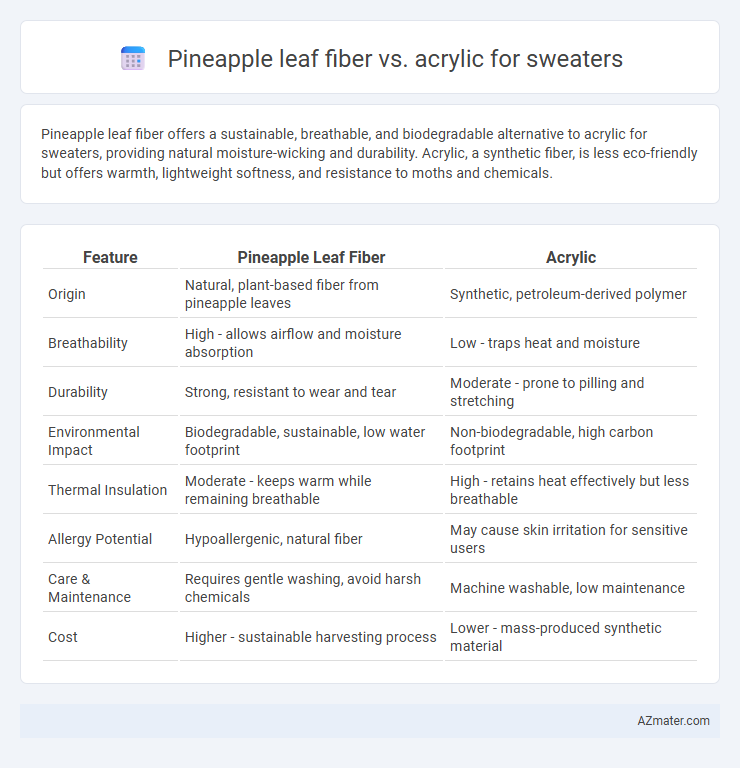Pineapple leaf fiber offers a sustainable, breathable, and biodegradable alternative to acrylic for sweaters, providing natural moisture-wicking and durability. Acrylic, a synthetic fiber, is less eco-friendly but offers warmth, lightweight softness, and resistance to moths and chemicals.
Table of Comparison
| Feature | Pineapple Leaf Fiber | Acrylic |
|---|---|---|
| Origin | Natural, plant-based fiber from pineapple leaves | Synthetic, petroleum-derived polymer |
| Breathability | High - allows airflow and moisture absorption | Low - traps heat and moisture |
| Durability | Strong, resistant to wear and tear | Moderate - prone to pilling and stretching |
| Environmental Impact | Biodegradable, sustainable, low water footprint | Non-biodegradable, high carbon footprint |
| Thermal Insulation | Moderate - keeps warm while remaining breathable | High - retains heat effectively but less breathable |
| Allergy Potential | Hypoallergenic, natural fiber | May cause skin irritation for sensitive users |
| Care & Maintenance | Requires gentle washing, avoid harsh chemicals | Machine washable, low maintenance |
| Cost | Higher - sustainable harvesting process | Lower - mass-produced synthetic material |
Introduction: The Rise of Sustainable Fibers in Fashion
Pineapple leaf fiber offers a biodegradable and eco-friendly alternative to conventional acrylic used in sweaters, which is derived from non-renewable petroleum sources. This sustainable fiber boasts high tensile strength, breathability, and natural moisture-wicking properties, making it suitable for comfortable and durable knitwear. As fashion brands shift towards environmentally responsible materials, pineapple leaf fiber emerges as a valuable innovation in reducing textile waste and lowering carbon footprints.
Overview of Pineapple Leaf Fiber: Origins and Production
Pineapple leaf fiber, derived from the leaves of the Ananas comosus plant native to Southeast Asia, is a sustainable and eco-friendly textile material primarily produced in the Philippines. The extraction process involves decorticating pineapple leaves to separate long, durable fibers that are then cleaned, spun, and woven into fabric suitable for sweaters. This natural fiber offers biodegradable properties, breathability, and a unique texture, distinguishing it from synthetic materials like acrylic.
Acrylic Fiber: Characteristics and Manufacturing Process
Acrylic fiber is a synthetic material made from polymerization of acrylonitrile, known for its lightweight, softness, and excellent insulation properties, making it a popular choice for sweaters. Its manufacturing process involves the solution polymerization of acrylonitrile, followed by spinning into fibers and heat treatment to enhance strength and elasticity. Compared to pineapple leaf fiber, acrylic offers greater moisture resistance, colorfastness, and durability, though it is less sustainable due to its petroleum-based origin.
Environmental Impact: Pineapple Leaf Fiber vs Acrylic
Pineapple leaf fiber is a sustainable textile choice derived from agricultural waste, reducing the need for synthetic fibers and minimizing environmental pollution. It is biodegradable and requires less energy and water in processing compared to acrylic, which is a petroleum-based synthetic fiber contributing to microplastic pollution and greenhouse gas emissions. The use of pineapple leaf fiber in sweaters significantly lowers the overall carbon footprint and promotes eco-friendly fashion alternatives.
Breathability and Comfort: Comparing Sweater Performance
Pineapple leaf fiber offers superior breathability compared to acrylic, allowing better air circulation and moisture management in sweaters, which enhances overall comfort. The natural fiber's lightweight and hypoallergenic properties reduce skin irritation, making it ideal for sensitive skin, whereas acrylic tends to trap heat and moisture, potentially causing discomfort. Sweaters made from pineapple leaf fiber provide a more breathable and comfortable wearing experience, especially in warmer conditions.
Durability and Longevity: Wear and Care Differences
Pineapple leaf fiber offers superior durability compared to acrylic, as its natural strength resists pilling and maintains fabric integrity over time, making it ideal for long-lasting sweaters. Sweaters made from pineapple leaf fiber require gentle washing and air drying to preserve fiber structure, while acrylic garments are more prone to stretching and fading with frequent machine washing. Pineapple leaf fiber also naturally resists microbial growth, enhancing longevity by reducing odor and degradation, whereas acrylic fibers can trap odors and wear down faster with improper care.
Cost Analysis: Affordability of Pineapple Leaf Fiber vs Acrylic
Pineapple leaf fiber offers a cost-effective alternative to acrylic in sweater production, with raw material costs typically lower due to its natural abundance and sustainable harvesting methods. While acrylic fibers incur higher manufacturing expenses due to synthetic processes and petrochemical sourcing, pineapple leaf fiber reduces overall expenses by minimizing energy consumption and chemical treatments. This affordability advantage makes pineapple leaf fiber an increasingly attractive choice for eco-conscious brands seeking budget-friendly yet sustainable sweater materials.
Style and Aesthetic Appeal in Sweaters
Pineapple leaf fiber sweaters offer a unique, natural texture with a matte finish that enhances an eco-friendly, artisanal style, appealing to consumers seeking sustainable fashion with a rustic yet refined aesthetic. Acrylic sweaters, by contrast, provide a smooth, consistent appearance with vibrant color retention, favoring contemporary, bold designs and a polished look. The choice between pineapple leaf fiber and acrylic significantly influences the sweater's visual appeal, balancing organic charm against synthetic vibrancy.
Market Demand and Consumer Perception
Pineapple leaf fiber sweaters are gaining market demand due to their sustainability, biodegradability, and hypoallergenic properties, appealing to eco-conscious consumers seeking natural and environmentally friendly fashion choices. Acrylic sweaters maintain strong market presence driven by affordability, versatility in color and texture, and ease of care, attracting budget-conscious buyers and those valuing synthetic durability. Consumer perception favors pineapple leaf fiber for its innovative eco-friendly appeal, while acrylic is often seen as a practical, low-cost alternative with less environmental impact awareness.
Conclusion: Choosing the Right Fiber for Sustainable Sweaters
Pineapple leaf fiber offers a biodegradable, eco-friendly alternative to acrylic, which is synthetic and derived from petroleum, making it less sustainable. Sweaters made from pineapple leaf fiber provide natural breathability, moisture-wicking, and durability, appealing to environmentally conscious consumers. Selecting pineapple leaf fiber supports sustainable fashion by reducing environmental impact compared to acrylic-based sweaters.

Infographic: Pineapple leaf fiber vs Acrylic for Sweater
 azmater.com
azmater.com